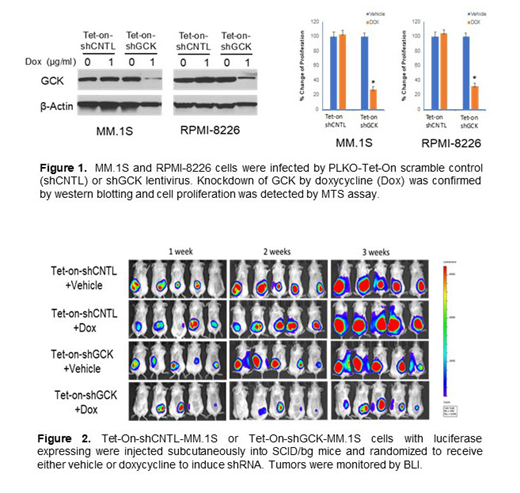Introduction: Next-generation sequencing revealed frequent mutations of the RAS/mitogen-activated protein kinase (MAPK) pathway, with mutations in NRAS, KRAS or BRAF in up to 50% of newly diagnosed MM patients1. The majority of the NRAS, KRAS and BRAF mutations occur in hotspots causing constitutive activation of the corresponding pathways2. Given the upstream activator role of Germinal Center Kinase (GCK) in the MAPK pathway, GCK might be an attractive therapeutic target in MM. Indeed, we recently discovered the critical role of GCK, also named mitogen-activated protein kinase kinase kinase kinase 2 (MAP4K2), in MM cell survival and growth.
Methods and Results: Our data show that GCK is higher expressed in RAS mutated MM cells compared to the wild type (WT) RAS MM cells. Silencing of GCK in RASmut MM cells (MM.1S and RPMI-8226) by using an inducible Tet-on-shGCK significantly decreased MM cell proliferation and induced cell death (Figure 1). In contrast, knockdown of GCK in RASwt MM cell lines (LP1 and U266) induced only modest inhibition of proliferation. The higher sensitivity to GCK knockdown in RASmut cells suggests that targeting GCK is especially effective in multiple myeloma which harbors RAS mutations. To exclude a potential off-target effect associated with GCK knockdown that led to the inhibition of MM proliferation, we set up an shGCK-resistant GCK allele (GCKshRNA-RES) by introducing mismatch mutations on the shRNA targeted sequences without changing the encoded amino acids. In the shGCK rescue experiment using GCKshRNA-RES we showed that all shRNA induced phenotypes (lack of growth, apoptosis and downstream effectors decrease) were corrected by the GCK resistant allele expression, ruling out the off-target hypothesis.
Moreover, we expanded the in vivo studies of GCK knockdown on MM tumor progression. To monitor the tumor progression, we transduced MM.1S cells with firefly luciferase and established an inducible GCK knockdown system. Luciferase-expressing GCK inducible knockdown MM cells or non-targeting control shRNA (shCNTL) transduced MM cells were s.c. injected into SCID/Beige mice and the tumor progression was monitored by bioluminescence imaging. Doxycycline (for induction of shRNA) or vehicle treatment were started after the tumor was established on day 16 to induce shGCK and subsequently silence GCK expression. In contrast to the vehicle-treated MM.1S-Tet-on-shGCK or doxycycline-treated MM.1S-Tet-on-shCNTL tumors, doxycycline-treated animals bearing MM.1S-Tet-on-shGCK xenografts showed a significant inhibition (P<0.001) of tumor growth (Figure 2). Thus, GCK is also required for tumor growth.
Lysine 45 is critical for GCK kinase activity. Point mutation of K45A will completely abolish its kinase activity. We introduced K45A mutation into GCKshRNA-RES (GCKshRNA-RESK45A→ shGCK resistant and kinase dead GCK). Tet-on-shGCK with GCKshRNA-RES or GCKshRNA-RESK45A were co-transduced in MM.1S cells. As expected, the GCK knockdown effects were rescued by GCKshRNA-RES but not by the kinase-dead mutant GCKshRNA-RESK45A. In contrast to GCKshRNA-RES, GCKshRNA-RESK45A failed to stimulate MM cell proliferation, to suppress MM cells apoptosis and to restore the downstream effectors expression. Our findings demonstrated that GCK kinase activity is required for its function in myeloma cell physiology.
Conclusion: Taken together, our findings provide a rationale for the clinical evaluation of targeting GCK in MM patients and the role of GCK in MM tumorigenesis as well as drug resistance. The subsequent development of small molecules inhibiting this pathway, such as GCK kinase inhibitors, will address the unmet need of developing targeted treatments for RASmut myeloma and potentially for other RASmut malignancies.
References
1. Walker, B.A., et al. Mutational Spectrum, Copy Number Changes, and Outcome: Results of a Sequencing Study of Patients With Newly Diagnosed Myeloma. J Clin Oncol33, 3911-3920 (2015).
2. Xu, J., et al. Molecular signaling in multiple myeloma: association of RAS/RAF mutations and MEK/ERK pathway activation. Oncogenesis6, e337 (2017).
Marcireau:Sanofi: Employment. Lentzsch:Caelum Biosciences: Equity Ownership, Membership on an entity's Board of Directors or advisory committees; Janssen: Consultancy; Takeda: Consultancy; BMS: Consultancy; Proclara: Consultancy; Abbvie: Consultancy; Clinical Care Options: Speakers Bureau; Sanofi: Consultancy, Research Funding; Multiple Myeloma Research Foundation: Honoraria; International Myeloma Foundation: Honoraria; Karyopharm: Research Funding; Columbia University: Patents & Royalties: 11-1F4mAb as anti-amyloid strategy; Bayer: Consultancy.
Author notes
Asterisk with author names denotes non-ASH members.


This feature is available to Subscribers Only
Sign In or Create an Account Close Modal